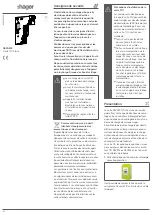
Chapter 1: Installation
Manual Number: 000750-006-5
Page 5
RS-485 Enable Modes
RS-485 is ideal for multi-drop or network environments. RS-485 requires a tri-state driver (not
dual-state) that will allow the electrical presence of the driver to be removed from the line. The
driver is in a tri-state or high impedance condition when this occurs. Only one driver may be active
at a time and the other driver(s) must be tri-stated. The output modem control signal
R
equest
T
o
S
end (RTS) is typically used to control the state of the driver. Some communication software packages
refer to RS-485 as RTS enable or RTS block mode transfer.
One of the unique features of the ULTRA-485 is the ability to be RS-485 compatible without the
need for special software or drivers. This ability is especially useful in Windows, Windows NT, and
OS/2 environments where the lower level I/O control is abstracted from the application program.
This ability means that the user can effectively use the ULTRA-485 in a RS-485 application with
existing (i.e. standard RS-232) software drivers.
Header E5:
This header is used to control the RS-485 mode functions for the transmitter circuit.
The selections are ‘RTS’ enable, ‘Auto’ enable, or ‘422’ which means always enabled. The ‘Auto’
enable feature automatically enables/disables the RS-485 transmitter circuit. The ‘RTS’ mode uses
the ‘RTS’ modem control signal to enable the RS-485 transmitter circuit and provides backward
compatibility with existing software products. The ‘422’ mode allows the port to be used in a point to
point RS-422 application where the tri-stating of the transmitter circuit is not required.
RTS
422
AUTO
E5
TX
Auto
Driver automatically Enabled/Disabled
RTS
Driver Enabled by UART RTS signal
422
Driver always Enabled
Figure 5: Header E5 RS-485 Transmit Mode
NOTE:
This jumper is in the "422" position. Note that the modem control outputs (RTS, DTR) are
only valid when Header E5 is in the 422 mode.











































